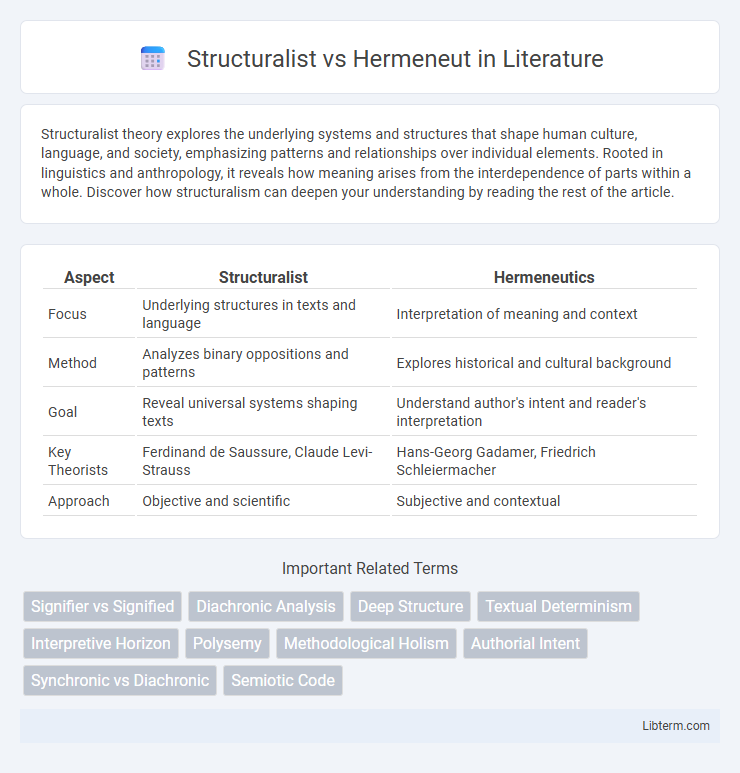Structuralist theory explores the underlying systems and structures that shape human culture, language, and society, emphasizing patterns and relationships over individual elements. Rooted in linguistics and anthropology, it reveals how meaning arises from the interdependence of parts within a whole. Discover how structuralism can deepen your understanding by reading the rest of the article.
Table of Comparison
| Aspect | Structuralist | Hermeneutics |
|---|---|---|
| Focus | Underlying structures in texts and language | Interpretation of meaning and context |
| Method | Analyzes binary oppositions and patterns | Explores historical and cultural background |
| Goal | Reveal universal systems shaping texts | Understand author's intent and reader's interpretation |
| Key Theorists | Ferdinand de Saussure, Claude Levi-Strauss | Hans-Georg Gadamer, Friedrich Schleiermacher |
| Approach | Objective and scientific | Subjective and contextual |
Introduction to Structuralism and Hermeneutics
Structuralism emphasizes analyzing cultural phenomena through underlying systems and structures, such as language and societal norms, to reveal patterns that shape human experience. Hermeneutics centers on interpreting texts and human expressions by exploring context, subjective meanings, and historical background to uncover deeper understanding. Both approaches offer distinct frameworks: structuralism seeks universal codes while hermeneutics prioritizes individual interpretation and meaning-making.
Historical Development of Structuralism
Structuralism emerged in the early 20th century, rooted in the linguistic theories of Ferdinand de Saussure, who emphasized the underlying structures of language that shape meaning. This approach gained prominence through figures like Claude Levi-Strauss in anthropology, who applied structuralist principles to myths and cultural phenomena, highlighting universal patterns across societies. Hermeneutics, contrastingly, developed through the works of Friedrich Schleiermacher and Hans-Georg Gadamer, focusing on interpreting texts through historical context and subjective understanding rather than abstract structures.
The Origins and Evolution of Hermeneutics
Hermeneutics originated in ancient Greek philosophy, evolving from biblical exegesis to a comprehensive method for interpreting texts and human experiences. The tradition flourished with thinkers like Friedrich Schleiermacher, Wilhelm Dilthey, and Hans-Georg Gadamer, who emphasized understanding context, authorial intent, and historicity. Contrasting with Structuralism's focus on language systems and underlying structures, Hermeneutics prioritizes meaning-making through interpretive dialogue and the fusion of horizons between interpreter and text.
Core Principles of Structuralist Theory
Structuralist theory centers on understanding human culture and cognition through underlying structures, such as language, myths, and social systems, which organize meaning independently of individual interpretation. It emphasizes binary oppositions and the idea that elements acquire significance through their relationship within a system, rather than in isolation. This approach contrasts with hermeneutics, which prioritizes subjective interpretation and the contextual understanding of texts or social phenomena.
Key Concepts in Hermeneutic Approach
Hermeneutic approach centers on understanding meaning through interpretation, emphasizing context, intentionality, and the dynamic interaction between the interpreter and the text. Key concepts include the hermeneutic circle, where comprehension evolves through a continuous interplay between parts and whole, and the role of preconceptions or "pre-understanding" that shapes interpretation. This approach contrasts with Structuralism's focus on underlying structures and systems, highlighting subjective meaning and historical context as essential to grasping significance.
Methodological Differences: Structure vs. Interpretation
Structuralist methodology emphasizes analyzing underlying systems and patterns that shape cultural phenomena, focusing on universal structures such as language, myths, and social relations. Hermeneutics prioritizes interpretation, seeking to understand meaning within specific contexts by exploring authorial intent, historical background, and subjective experience. The structuralist approach aims for objective, scientific analysis, while hermeneutics embraces the fluid and dynamic nature of meaning creation through dialogue and context.
Major Thinkers: Structuralists and Hermeneuts
Structuralists like Ferdinand de Saussure and Claude Levi-Strauss emphasize underlying systems and structures in language and culture, interpreting meaning through relationships within these frameworks. Hermeneutic thinkers such as Hans-Georg Gadamer and Paul Ricoeur focus on interpretive processes, understanding texts and human experience through historical context and dialogue. Both approaches reveal contrasting methodologies: structuralism seeks universal, objective patterns, while hermeneutics prioritizes subjective understanding and meaning-making.
Applications in Literary and Cultural Analysis
Structuralist analysis in literary and cultural studies emphasizes underlying systems such as language, myths, and social structures to uncover universal patterns and relationships within texts and societies. Hermeneutics prioritizes interpretive methods, focusing on the contextual meanings, authorial intent, and historical background to derive deeper understanding from cultural artifacts. Together, these approaches enable scholars to analyze literature and culture by combining objective structural frameworks with subjective, context-driven interpretation.
Criticisms and Limitations of Each Approach
Structuralism faces criticism for its rigid focus on underlying systems, often neglecting individual agency and historical context, which limits its ability to account for fluid cultural meanings. Hermeneutics is challenged for its subjective interpretation process, risking excessive relativism and a lack of empirical rigor that can undermine the consistency of textual understanding. Both approaches struggle with balancing objective analysis and the nuanced complexities of meaning in social and literary studies.
Contemporary Relevance and Future Directions
Structuralism continues to influence contemporary fields like linguistics, anthropology, and literary theory by emphasizing underlying systems and patterns in culture and language. Hermeneutics remains essential in philosophy, theology, and social sciences through its focus on interpretation, context, and meaning-making processes. Future directions suggest an interdisciplinary approach blending structuralist analysis with hermeneutic emphasis on subjective understanding to address complex societal and technological challenges.
Structuralist Infographic

 libterm.com
libterm.com